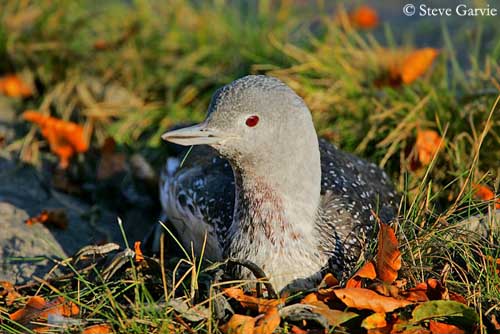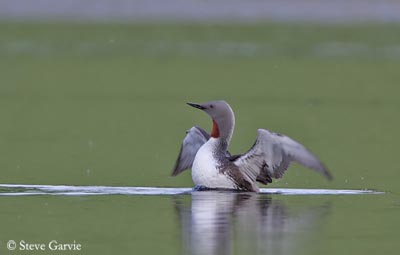
Red-throated Diver (Loon)
Gavia stellata
Gaviiforme Order – Gaviidae Family
BIOMETRICS:
Length: 53-69 cm
Wingspan: 106-116 cm
Weight: 988-2460 g
DESCRIPTION:
The Red-throated Diver is a slender and graceful bird, with slightly uptilted bill. It is the smallest member of the family Gaviidae.
In breeding plumage, underparts are dark brown, head and neck are greyish, with red throat patch on fore neck. This patch appears red only under good lighting. Otherwise, it appears rather dark.
Underparts are white and tail is black. The rear neck is white finely streaked black down to the base.
PROTECTION / THREATS / STATUS:
The Red-throated Diver declines in some parts of the range, due to human disturbances, local alteration of water levels and pollution of these waters.
However, populations are still important and the species is not threatened at this moment.
Fr: Plongeon catmarin
All: Sterntaucher
Esp: Colimbo Chico
Ital: Strolaga minore
Nd: Roodkeelduiker
Russe: Краснозобая гагара
Sd: Smålom
Photographers:
Steve Garvie
RAINBIRDER Photo galleries
Tom Grey
Tom Grey's Bird Pictures
René Lortie
http://rlortie.ca
Text by Nicole Bouglouan
Sources:
HANDBOOK OF THE BIRDS OF THE WORLD vol 1 by Josep del Hoyo-Andrew Elliot-Jordi Sargatal - Lynx Edicions - ISBN: 8487334105
THE COMPLETE BOOK OF BRITISH BIRDS – Written by “Royal Society for the Protection of Birds” experts - Préface de Magnus Magnusson - Michael Cady- Rob Hume Editors - ISBN: 0749509112
THE HANDBOOK OF BIRD IDENTIFICATION FOR EUROPE AND THE WESTERN PALEARCTIC by Mark Beaman, Steve Madge - C.Helm - ISBN: 0713639601
Animal Diversity Web (University of Michigan Museum of Zoology)
The Birds of North America online
What Bird-The ultimate Bird Guide (Mitchell Waite)
Wikipedia (Wikipedia, The Free Encyclopedia)

In winter plumage, face and fore neck are pure white and upperparts are dark brown finely spotted white. The red throat-patch is the latest ornament which disappears in autumn.
Usually, males are slightly larger than females, with larger head and stronger bill. Neck is thick. The nostrils are narrow and elongated, well adapted to diving. Eyes are red, especially in breeding adults.
The body is made to swim with the black, short and powerful legs, situated far on lower belly. They are adapted to move into the water, but the bird does not walk easily on the ground. The three front toes are joined by a membrane, and the tail is short.
The juvenile resemble adults in winter.
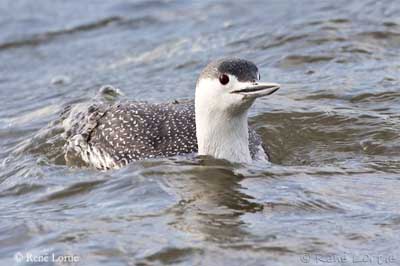
VOICE: SOUNDS BY XENO-CANTO
The Red-throated Diver is silent in winter, but in flight, it utters a loud cackling on single pitch. Sometimes, it gives briefer calls.
The call is very resonant and carries very far. It is an advertising call for an established territory. This sound resembles a low whistle and includes very soft mixed notes. Both sexes utter this call at the same moment.
When alarmed or threatened, divers produce a crow-like croaking, as alarm call. When flying over the territory and surroundings, the diver utters short, repeated goose-like cackling.

HABITAT:
The Red-throated Diver breeds in freshwater, mainly in well open marshes, and in varied water surfaces. It often nests in small pools.
During winter, it frequents inland waters along sheltered coasts, and may be seen occasionally inland.
RANGE:
The Red-throated Diver is a circumpolar species, from Antarctic to temperate latitudes. It is found in Northern Atlantic and Pacific coasts, North American Great Lakes, Black, Caspian and Mediterranean Seas.
This species is migratory and moves southwards and towards the sea after the breeding season. We can see flocks of up to 200-1200 birds.
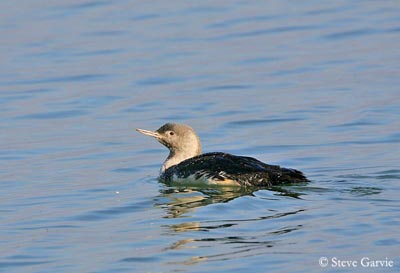
BEHAVIOUR:
The Red-throated Diver does not walk easily on the ground, but it is able to travel long distances on land. When disturbed, it may move to other pool with the chicks.
This is the slightest and most agile species. With its large wingspan, it can take off or land directly on the ground.
After the breeding season, the divers move to coastal waters and gather in large flocks at rich feeding areas. They forage and feed together. Some aggressive behaviour may be observed, but without repercussions.
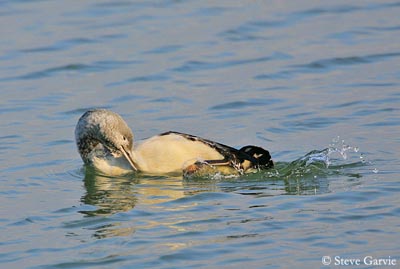
The Red-throated Diver spends most time to preen. It also bathes, performing wing-beats, rolls, dives and somersaults. It sleeps mainly on water, but also on the ground during the nesting period.
Territorial disputes involve some displays with males crossing the water surface by gliding and calling loudly, as in race.
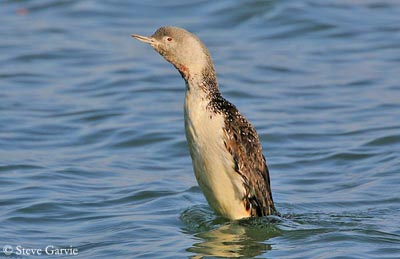
It feeds on fish, pursuing the prey underwater. It catches it with the bill instead to jab it. It is able to dive to 9 metres depth, and may remain underwater during about one minute.
FLIGHT:
The Red-throated Diver does not need to run over long distance to take off. Its large wingspan allows it to take flight quickly. That explains why it nests on small pools in tundra and marshes.
It performs fairly rapid wing-beats with V-shaped wings.
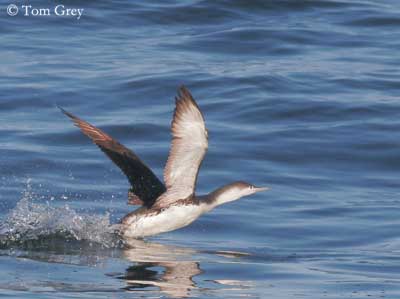
REPRODUCTION:
The Red-throated Diver is monogamous with permanent pair-bonds.
Both mates spend the winter together and start the reproduction very soon after some short displays. Frequent copulations occur on the ground. They start as soon as they arrive at nest, and may continue until the laying.
Male selects the nest-site, always close to the water. It is a simple heap of plant matter. Several pairs may form small colonies, mainly when a few suitable nest-sites are available within the feeding area. They only defend the close proximity of the nest.
When the birds are isolated for nesting, they may become more aggressive and defend larger territory including ponds outside their own area.
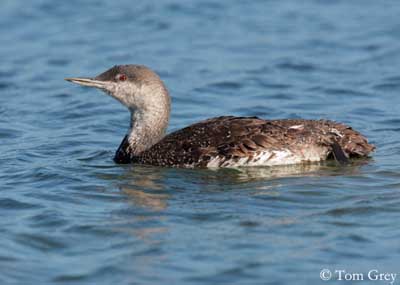
In May, female lays 1-3 eggs, usually two. Incubation lasts about 27 days by both parents, but mainly by female. Incubation starts with the first egg laid, involving different ages and sizes between the chicks. When parents arrive at nest, the largest get more food and often the smallest dies.
At 2-3 weeks of age, youngs spend most time swimming, but they depend on parents for food until they grow up completely. They fledge at about 7 weeks, and reach their sexual maturity at 2-3 years.
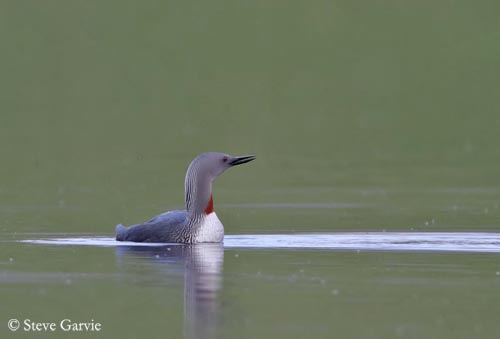
DIET:
The Red-throated Diver feeds primarily on fish of several species, but it also consumes crustaceans, prawns, molluscs, snails and aquatic insects, and some plant matter.
